1900s
Blindfold Pigs
Back in 1905, celebrities of the day were asked to try to draw a pig while blindfolded. The results were printed in The Strand magazine:
Most of the names I don't recognize. But I do know Caton Woodville (middle of the second row from the top). He was an artist who specialized in war scenes, such as his rendition of the Charge of the Light Brigade. I'm guessing his paintings aren't cheap. But I wonder how much his blindfold pig would go for?
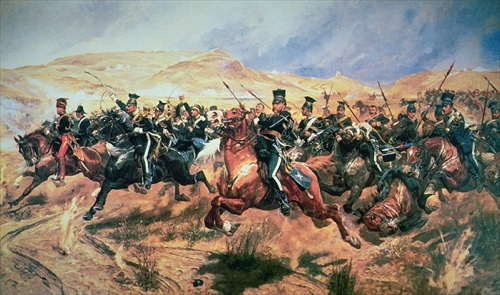
Posted By: Alex - Sun Apr 07, 2013 -
Comments (5)
Category: Art, 1900s
Outdoor Manhattan Banana Food Fight
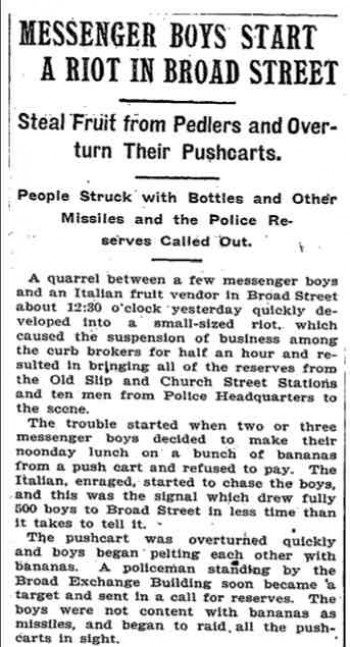

I would have paid good money for a safe ringside seat at this riot.
From The New York Times for April 24, 1901.
Posted By: Paul - Fri Mar 22, 2013 -
Comments (4)
Category: Food, Riots, Protests and Civil Disobedience, 1900s, Bananas
The Philadelphia Phonograph School of Languages for Parrots
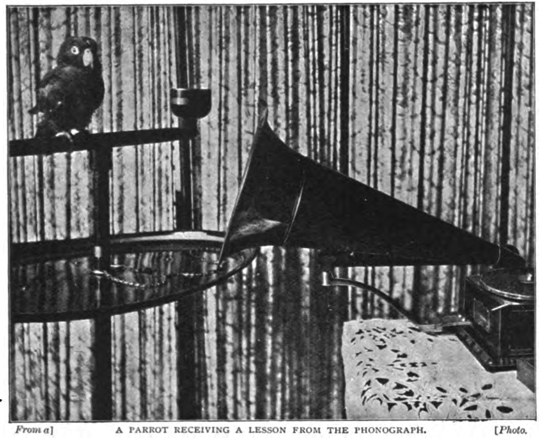
It came into existence circa 1903. Details from The Strand Magazine:
This is the twentieth-century method of teaching a parrot. Hitherto he has been taught by tutors, generally women, and, if the truth must be told, he has not been altogether a satisfactory or exemplary pupil. First of all his teacher has to repeat the phrase or sentence over and over again, hundreds and thousands of times, before "Pretty Polly" is able to pronounce it. This in itself is a tiresome procedure, but it is rendered more fatiguing on account of the fact that the speaker must be hidden from the parrot. She has, therefore, to crouch behind a screen or to cover the cage of the bird with a large hood. The former is regarded as the best method, as no self-respecting parrot likes to be left alone in the dark, but to hide oneself secretly behind a screen and then repeat the words, "Pretty Polly," "Pretty Polly," a thousand times is surely not an enviable task.
By the new mode of teaching, however, no personal inconvenience of this nature is felt, for all the tutor has to do is to obtain a phonograph, secure a few records suitable for birds, and set the phonograph going in the parrot's ear. The bird, too, learns more quickly by this method than in the old way...
The fee for a full term of six months is eight pounds. Parrots are often sent, however, for a briefer period, when the rate charge is ten shillings per week, including, of course, board and lodging. Sometimes, when a pupil has to be taught unusual phrases—French or German sentences, for instance—the tuition rate is a little higher.
Posted By: Alex - Fri Feb 22, 2013 -
Comments (5)
Category: Animals, School, 1900s
Doc Owens, Con Man
As early as December 1900, the notorious Doc Owens was making headlines, having established his racket of fleecing sea-going sheep.
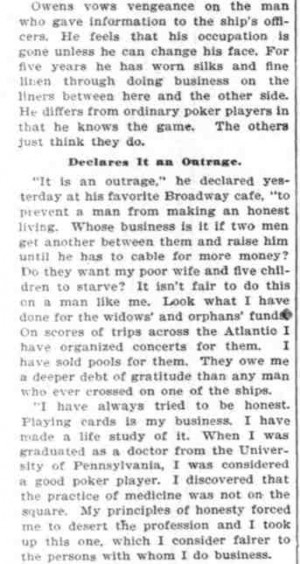
READ LEFT-HAND COLUMN, THEN RIGHT-HAND COLUMN, THEN SAME FOR THE TWO FOLLOWING.

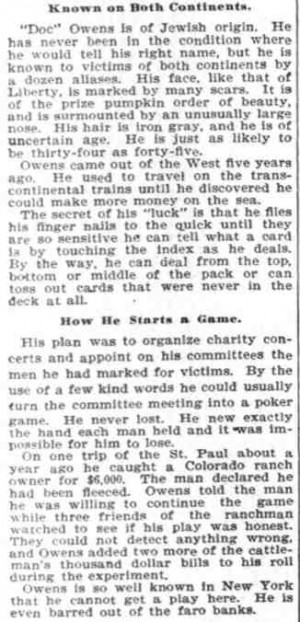
Three years later, The New York Times did a special feature on Owens and his fellows (with his photo miscaptioned).
Click here for very readable PDF download.
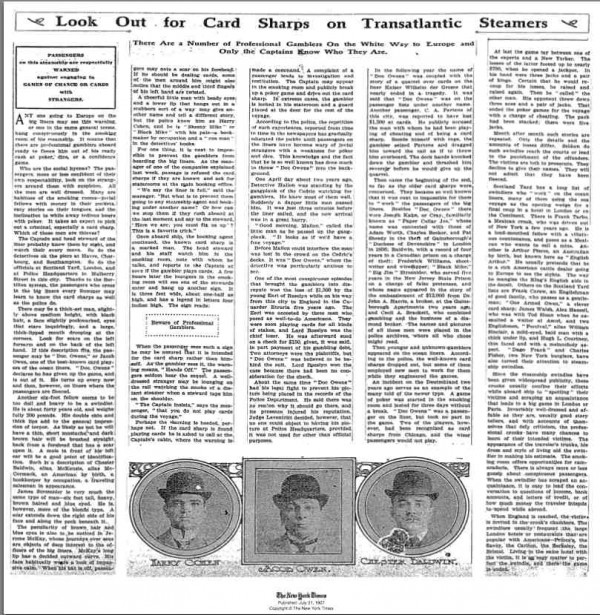
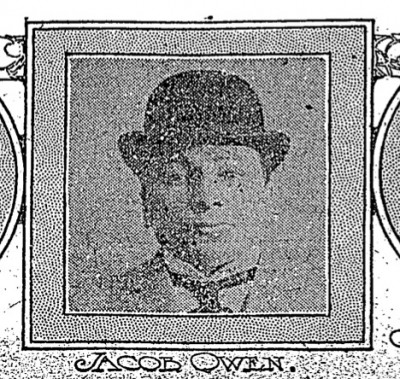
But Owens was to meet poetic justice in 1912, as our final piece reveals.

Posted By: Paul - Fri Feb 15, 2013 -
Comments (2)
Category: Crime, Death, Disasters, Frauds, Cons and Scams, Oceans and Maritime Pursuits, 1900s, 1910s, Gambling, Casinos, Lotteries and Other Games of Chance
Best Headline Juxtaposition Ever
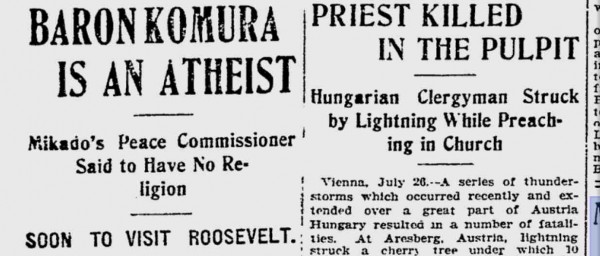
Original page here.
Posted By: Paul - Sun Feb 03, 2013 -
Comments (4)
Category: Newspapers, Religion, Synchronicity, 1900s
Westphal’s Auxiliator


[Click text to enlarge]
Here's an old-timey hair tonic with a weird name. The strange noun just means "helper."
Composed of "55% grain alcohol," it went down many an alcoholic's gullet, I'm sure.
Believe it or not, the tonic was mentioned in a SIMPSONS comicbook. If you look at their ad below, you'll see why. The mutant female user resembles the famed Springfield three-eyed fish.

Posted By: Paul - Tue Jan 22, 2013 -
Comments (4)
Category: Business, Advertising, Products, Elderly and Seniors, Comics, 1900s, 1910s, 1920s, Nineteenth Century, Hair and Hairstyling
Marvel Whirling Spray

Marvel Whirling Spray was a feminine hygiene product marketed in the early 20th century. It stopped being made and fell into obscurity for 100 years until the early 21st century, when it earned a place in comic-book history.
Alan Moore included a reprint of one of the Marvel Whirling Spray ads in an issue of The League of Extraordinary Gentlemen (Vol. 1, #5). An executive at DC (publishers of the comic) saw the ad and became worried that their rival, Marvel Comics, would take offense — even though Marvel Whirling Spray was a real product that existed before Marvel Comics. So he ordered the entire print run destroyed. The few copies that survived are now considered rare collector's items. More details at recalledcomics.com.

Posted By: Alex - Sat Jan 19, 2013 -
Comments (4)
Category: Hygiene, Baths, Showers and Other Cleansing Methods, Products, 1900s
Rat-Killing Lessons, 1907
Back in the day, students were taught the important subjects at school, such as how to kill rats. Here's a description of rat-killing lessons at the Farm and Trade School on Thompson's Island, circa 1907. From Rats and Rat Riddance (1914), by Edward Howe Forbrush:The pictures show the schoolboys showing off their kill, as well as the rats strung up.
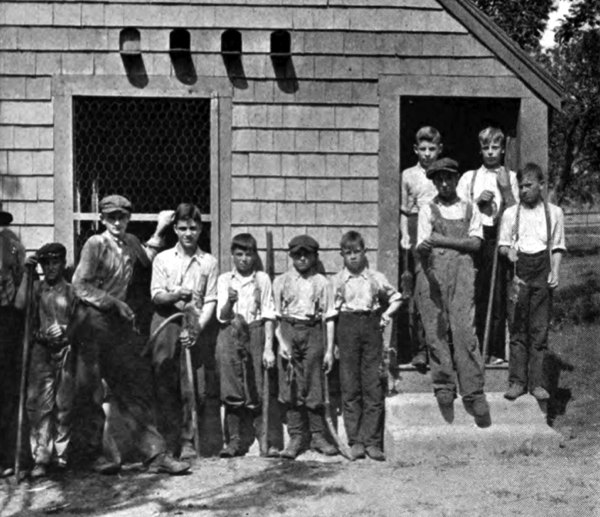
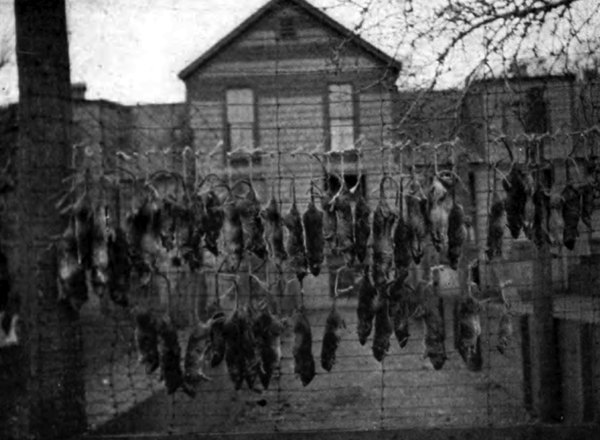
Posted By: Alex - Mon Dec 31, 2012 -
Comments (6)
Category: Animals, School, 1900s
1907: Big Year for Faux Gorillas
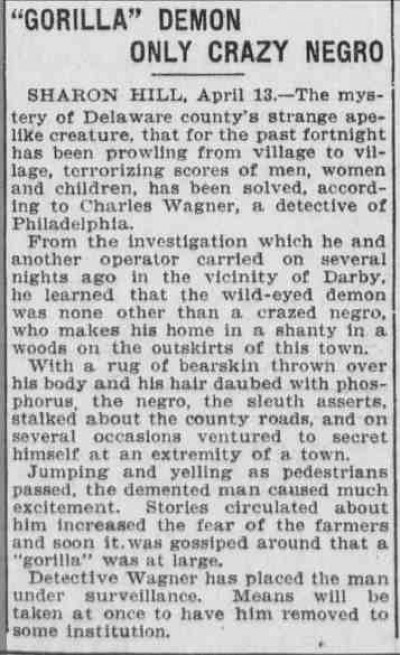
Original article here.


Original article here.
Posted By: Paul - Mon Dec 24, 2012 -
Comments (3)
Category: Animals, Human Marvels, Stereotypes and Cliches, Superstition, 1900s, Fictional Monsters
Dying pigs’ squeal used to sell pianos
Found in Popular Mechanics, October 1907:An ingenious piano salesman travels through the country, taking several instruments with him. To draw a crowd he gives a free evening entertainment with a moving picture machine. Between each series of views he demonstrates on the pianos. One of his pictures shows the progress of events at a packing house. To make the scenes in the killing room realistic he visited the plant and secured some phonograph records of the porkers as they let out some vigorous remarks. Now when the moving picture reaches the pig sticking act, he turns on his phonograph and his visitors can see and hear just as if they were actually present at the original scene of operations.
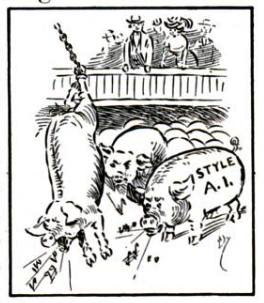
I wonder how many pianos he sold using this method.
Posted By: Alex - Sun Dec 23, 2012 -
Comments (5)
Category: Animals, Music, Advertising, 1900s

| Who We Are |
|---|
| Alex Boese Alex is the creator and curator of the Museum of Hoaxes. He's also the author of various weird, non-fiction, science-themed books such as Elephants on Acid and Psychedelic Apes. Paul Di Filippo Paul has been paid to put weird ideas into fictional form for over thirty years, in his career as a noted science fiction writer. He has recently begun blogging on many curious topics with three fellow writers at The Inferior 4+1. Contact Us |




